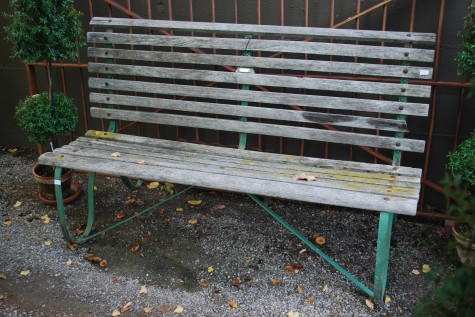 I could easily picture Gertrude Jekyll perched on this old English wood garden bench. Wearing a long skirt, a cardigan, and serviceable brogans, I can hear her in dignified fashion holding forth on some garden design topic or another with as much energy as authority. This straight-backed bench, of slight design and simple materials, is unmistakably English in origin. I have never been to Britain, and I know few people of British extraction-but I have looked at vintage and antique English garden furniture long enough to successfuly guess its origin.
I could easily picture Gertrude Jekyll perched on this old English wood garden bench. Wearing a long skirt, a cardigan, and serviceable brogans, I can hear her in dignified fashion holding forth on some garden design topic or another with as much energy as authority. This straight-backed bench, of slight design and simple materials, is unmistakably English in origin. I have never been to Britain, and I know few people of British extraction-but I have looked at vintage and antique English garden furniture long enough to successfuly guess its origin.
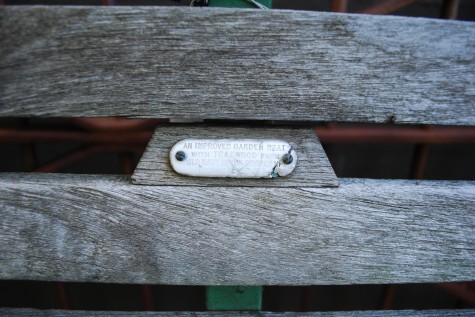
The old porcelain tag on this bench reveals the teak came from decommissioned and broken ships of the Royal Navy. How like the British to recycle disaster and the materials thereof without fanfare. What people designed and made for their gardens was so much a product of who they were, and the culture from whence they came. I have a much tougher time visually determining the origin of new garden ornament. Designers are able to access design and materials from all over the world now. I find some contemporary teak furniture cold and lacking flavor and identity, for this reason.
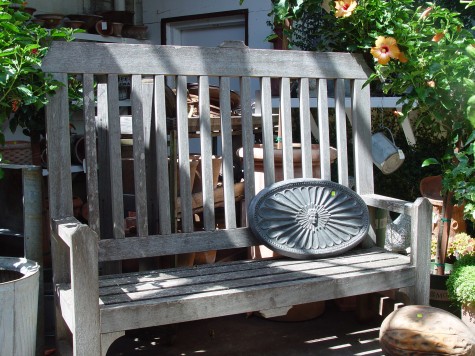 This decidedly English style high backed bench of utterly simple design is a contemporary piece that seems authentic to the culture of its origin. It used to be there were no designers, just craftspeople with good sense about proportion, practicality, and sturdy construction. What worked was also beautiful. This bench doesn’t try too hard. No doubt it will be in service a very long time, given its heft. Its visual heft makes it a good candidate for a special spot in a garden. It could just as easily hold a number of people waiting for a bus, or a pile of kids intent on climbing it.
This decidedly English style high backed bench of utterly simple design is a contemporary piece that seems authentic to the culture of its origin. It used to be there were no designers, just craftspeople with good sense about proportion, practicality, and sturdy construction. What worked was also beautiful. This bench doesn’t try too hard. No doubt it will be in service a very long time, given its heft. Its visual heft makes it a good candidate for a special spot in a garden. It could just as easily hold a number of people waiting for a bus, or a pile of kids intent on climbing it.
 Sir Edwin Lutyens was a British architect of great renown whose practice spanned the late 19th century and early 2oth century. Gardeners all over the world know of him, from his association with Gertrude Jekyll. Her steadfast support of his career, and the projects upon which they collaborated are well documented. The most beautiful bench of his design might be the Hestercombe bench, but the bench most often associated with his name is known as the Lutyens bench. The distinctively curved back and scrolled arms have been the inspiration for subsequent English bench-makers; this version is a beauty.
Sir Edwin Lutyens was a British architect of great renown whose practice spanned the late 19th century and early 2oth century. Gardeners all over the world know of him, from his association with Gertrude Jekyll. Her steadfast support of his career, and the projects upon which they collaborated are well documented. The most beautiful bench of his design might be the Hestercombe bench, but the bench most often associated with his name is known as the Lutyens bench. The distinctively curved back and scrolled arms have been the inspiration for subsequent English bench-makers; this version is a beauty.
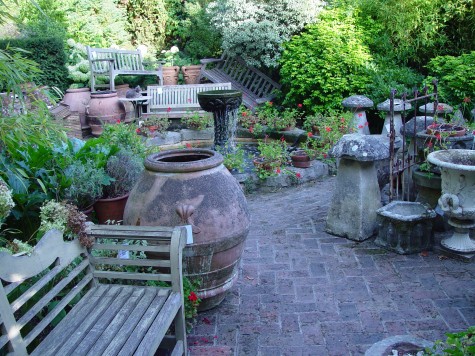 Many of our antique and vintage pieces come from dealers in England. Most of them represent garden objects from of other countries, not just their own. As much as the English gardener of my imagination is keenly interested in plants of all sizes, species and habit, the antique dealers we buy from with are game for anything that might endow a garden with beauty and history.
Many of our antique and vintage pieces come from dealers in England. Most of them represent garden objects from of other countries, not just their own. As much as the English gardener of my imagination is keenly interested in plants of all sizes, species and habit, the antique dealers we buy from with are game for anything that might endow a garden with beauty and history.
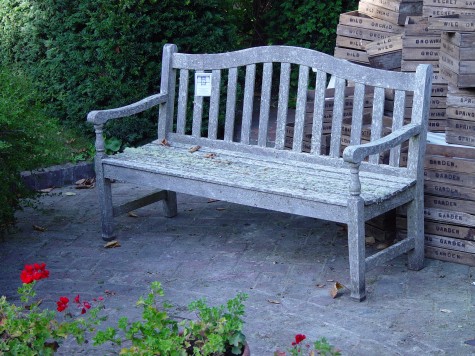 However, one must go to England to find English garden benches. Their modest and sturdy look is so appealing. Even the old benches clearly have many years of service yet to come. A colony of pale green lichens found a home on this bench-no doubt the result of many years of service in some English garden blessed with regular rain.
However, one must go to England to find English garden benches. Their modest and sturdy look is so appealing. Even the old benches clearly have many years of service yet to come. A colony of pale green lichens found a home on this bench-no doubt the result of many years of service in some English garden blessed with regular rain.
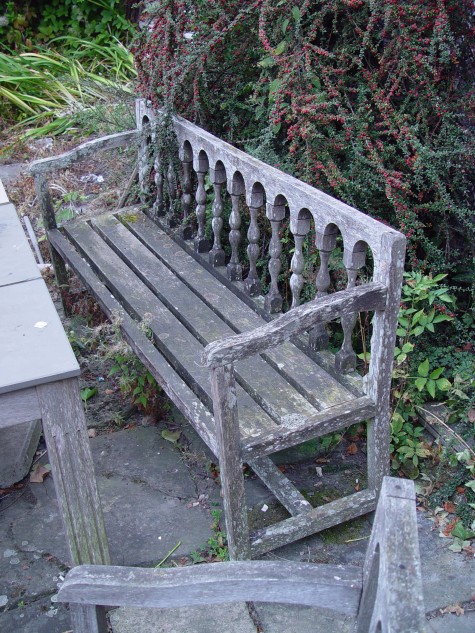 This quietly elegant spindle back bench is likewise mottled with colonies of this lichen and that moss. Its timeworn surface and low key design made it so easy to incorporate into a garden. British wood benches are team players.
This quietly elegant spindle back bench is likewise mottled with colonies of this lichen and that moss. Its timeworn surface and low key design made it so easy to incorporate into a garden. British wood benches are team players.
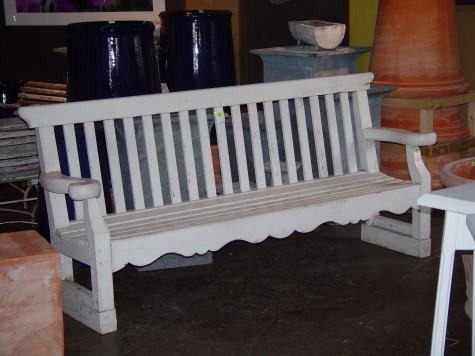 This old painted bench had sustained some dry rot from years of contact with the ground. We stabilized the legs from underneath, and placed it on a gravel terrace. Though 70 years old, I think my clients will enjoy it a good many more years. Painted furniture in a garden has a charm all its own. The frilly skirt and the angled back of this bench is a departure in form from most English benches I have known and loved-but how I like it.
This old painted bench had sustained some dry rot from years of contact with the ground. We stabilized the legs from underneath, and placed it on a gravel terrace. Though 70 years old, I think my clients will enjoy it a good many more years. Painted furniture in a garden has a charm all its own. The frilly skirt and the angled back of this bench is a departure in form from most English benches I have known and loved-but how I like it.
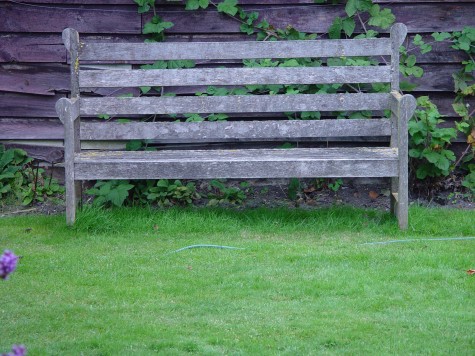
An old bench such as this one could quietly transform the garden into which it were placed. As Mary Keen says, “Nostalgia in gardening often surfaces as a longing for that older, deeper relationship between person and place that we rarely achieve in modern life.”
Leave a Comment